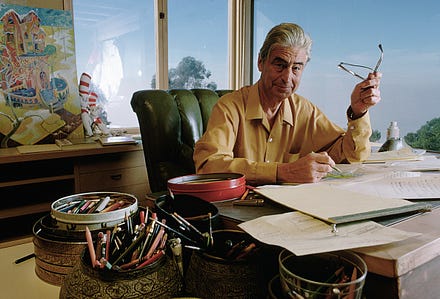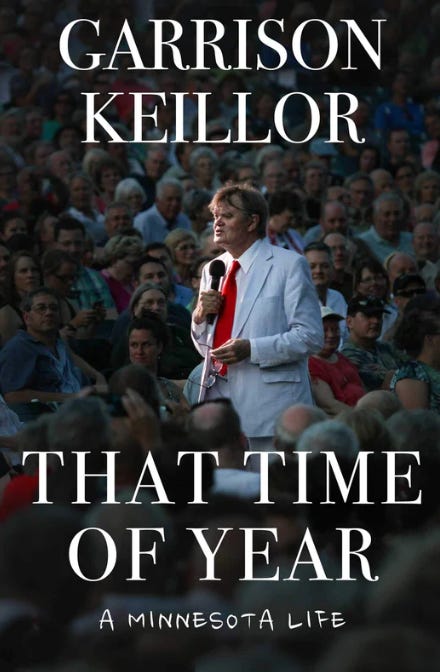|
 |
“Turning” by Joseph Mills from This Miraculous Turning. © Press, 53, 2014.
ORIGINAL TEXT AND AUDIO - 2017
It's the birthday of the novelist John Irving, born in Exeter, New Hampshire (1942). His first successful novel was The World According to Garp (1978). He's written many more novels since then, including The Cider House Rules (1978) and A Prayer for Owen Meany (1989). In addition to writing books, he also wrestled competitively until he was 34 years old, and he was voted into the National Wrestling Hall of Fame in 1992.
It's the birthday of the children's book author who wrote under the name Dr. Seuss, born Theodor Geisel, in Springfield, Massachusetts (1904). He published his first book for children, And to Think That I Saw It on Mulberry Street, in 1937. He went on to publish a series of fairly successful books for older children, and then, in 1955, an educational specialist asked him if he would write a book to help children learn how to read. Seuss was given a list of 300 words that most first-graders know, and he had to write the book using only those words. Seuss wasn't sure he could do it, but as he looked over the list, two words jumped out at him: "cat" and "hat."
Seuss spent the next nine months writing what would become The Cat in the Hat (1957). That book is 1,702 words long, but it uses only 220 different words. Parents and teachers immediately began using it to teach children to read, and within the first year of its publication it was selling 12,000 copies a month. A few years later, Seuss's publisher bet him $50 that he could not write a book using only 50 different words. Seuss won the bet with his book Green Eggs and Ham (1960), which uses exactly 50 different words, and only one of those words has more than one syllable: the word "anywhere."
It's the birthday of journalist and novelist Tom Wolfe, born in Richmond, Virginia (1931), the author of the books The Electric Kool-Aid Acid Test (1968), Radical Chic and Mau-Mauing the Flak Catchers (1970), and The Right Stuff (1979). He helped spark the "New Journalism" movement, which began in the 1960s.
He went to graduate school at Yale in the 1950s, and in the midst of the Red Scare wrote a thesis entitled The League of American Writers: Communist Organizational Activity Among American Writers, 1929–1942. He had a Ph.D., but rather than go into academia he decided to be a newspaper reporter. Then, in the early 1960s, there was a newspaper strike in New York City, and the paper he worked for was affected. He was out of a job for a while, and he decided to pitch an idea to Esquire magazine for a story about the hot-rod car culture around southern California.
The editor agreed, and Wolfe went out to L.A., hung around car shows, drag races, and demolition derbies, and ran up a $750 bill at a Beverly Hills hotel. He'd taken lots and lots of notes, but he couldn't figure out what the story should be or how to write it up —not even by the night before his magazine deadline. The editor told him to type up his notes, send them, and he'd go ahead and put together the story. Wolfe sat at his typewriter and banged out a letter to his editor with his ideas and observations. His editor liked it so much that he just removed the salutation ("Dear Byron") at the top and published Wolfe's notes as a feature article. The story was a huge hit and became the title piece in Wolfe's first published book, The Kandy-Kolored Tangerine Flake Streamline Baby (1965).
A few years later, he published The Electric Kool-Aid Acid Test (1968), a nonfiction novel about Ken Kesey and the Merry Pranksters. It became a cult classic almost right away. In chapter six, he writes about the bus the Merry Pranksters refurbished to drive around the country and convert people to their new religion:
I couldn't tell you for sure which of the Merry Pranksters got the idea for the bus, but it had the Babbs touch. It was a super prank, in any case. ... They started painting it and wiring it for sound and cutting a hole in the roof and fixing up the top of the bus so you could sit up there in the open air and play music, even a set of drums and electric guitars and electric bass and so forth, or you could just ride. Sandy went to work on the wiring and rigged up a system with which you could broadcast from inside the bus, with tapes over microphones, and it would blast outside over powerful speakers on top of the bus. There were also microphones outside that would pick up sounds along the road and broadcast them inside the bus. There was also a sound system inside the bus so you could broadcast to one another over the roar of the engine and the road. You could also broadcast over a tape mechanism so you said something, then you heard your own voice a second later in variable lag, and could rap off of that if you wanted to. ... The painting job, meanwhile, with everybody pitching in a frenzy of primary colors, yellows, oranges, blues, reds, was sloppy as hell, except for the parts Roy Seburn did, which were nice manic mandalas. Well, it was sloppy, but one thing you had to say for it, it was freaking lurid.
In an essay published in 2007, Tom Wolfe argued that the newspaper industry would stand a much better chance of survival if newspaper editors encouraged reporters to "provide the emotional reality of the news, for it is the emotions, not the facts, that most engage and excite readers and in the end are the heart of most stories." He said there are exactly four technical devices needed to get to "the emotional core of the story." They are the specific devices, he said, "that give fiction its absorbing or gripping quality, that make the reader feel present in the scene described and even inside the skin of a particular character."
The four: 1) constructing scenes; 2) dialogue — lots of it; 3) carefully noting social status details — "everything from dress and furniture to the infinite status clues of speech, how one talks to superiors or inferiors ... and with what sort of accent and vocabulary"; and 4) point of view, "in the Henry Jamesian sense of putting the reader inside the mind of someone other than the writer."
In a couple of paragraphs in The Electric Kool-Aid Acid Test, written more than 40 years ago, he showcased his four chosen techniques in a description of the Merry Pranksters bus test run:
They took a test run up into northern California and right away this wild-looking thing with wild-looking people was great for stirring up consternation and vague, befuddling resentment among the citizens. The Pranksters were now out among them, and it was exhilarating — "Look at the mothers staring at us!" — and it was going to be holy terror in the land. But there would also be people who would look up from out of their poor work-a-daddy lives in some town, some old guy, somebody's stenographer, and see this bus and register delight, or just pure open-invitation wonder. Either way, the Intrepid Travelers figured, there was hope for these people. They weren't totally turned off.
The bus also had great possibilities for altering the usual order of things. For example, there were the cops. One afternoon the Pranksters were on a test run in the bus going through the woods up north and a forest fire had started. There was smoke beginning to pour out of the woods and everything. Everybody on the bus had taken acid and they were zonked. The acid was in some orange juice in the refrigerator and you drank a paper cup full of it and you were zonked. Cassady was driving and barreling through the burning woods, wrenching the steering wheel this way and that way to his inner-wired beat, with a siren wailing and sailing through the rhythm.
A siren? It's a highway patrolman, which immediately seems like the funniest thing in the history of the world. Smoke is pouring out of the woods and they are all sailing through leaf explosions in the sky, but the cop is bugged about this freaking bus.
He's the author of the novels The Bonfire of the Vanities (1987), A Man in Full (1998), and I am Charlotte Simmons (2004). He said, "The reason a writer writes a book is to forget a book and the reason a reader reads one is to remember it."
Be well, do good work, and keep in touch.®
RELEASE WEEK - March 7th
That Time of Year: A Minnesota Life (slightly revised) Softcover
You’re a free subscriber to The Writer's Almanac with Garrison Keillor. Your financial support is used to maintain these newsletters, websites, and archive. Support can be made through our garrisonkeillor.com store, by check to Prairie Home Productions P.O. Box 2090, Minneapolis, MN 55402, or by clicking the SUBSCRIBE button. This financial support is not tax deductible.


